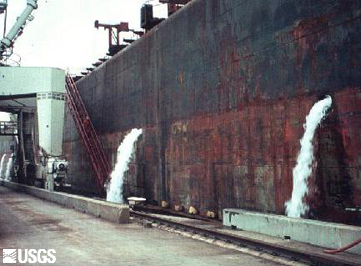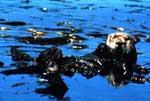- Home
- About S&T
- Taxa/Organisms
- Ecosystems
- Issues
- Methods & Tools
- Reports & Publications
- Location
- Search
October 2008 | Publisher: USGS (Soundwaves) | Format: URL
soundwaves.usgs.gov — Three years after Hurricanes Katrina and Rita ravaged the U.S. Gulf Coast, the region was hit once again by a pair of large storms: Hurricane Gustav made landfall near Cocodrie, Louisiana, on September 1, 2008, as a strong Category 2 storm; and Hurricane Ike made landfall near Galveston, Texas, on September 13, 2008, also as a strong Category 2 More...

Publisher: USGS | Science Center: Western Ecological Research Center (WERC, Sacramento) | Format: URL
www.werc.usgs.gov — Sea otters (Enhydra lutris) are keystone predators in the nearshore environment of the eastern Pacific Ocean, in a food web composed of sea otter, sea urchin, and kelp forest. Without sea otters, the kelp forest can be overgrazed by sea urchins, which in turn can affect other species that depend on this ecosystem. This resource provides links to More...

Publisher: USGS | Science Center: Western Fisheries Research Center (WFRC, Seattle) | Format: URL
wfrc.usgs.gov — Ballast water discharges are the most significant cause of aquatic biological invasions in coastal waters, including the Great Lakes. Currently, treatment of ballast water prior to discharge at the receiving port offers significant promise to help control this problem. However, development of treatment technologies is limited by lack of objective More...

Publisher: USGS | Science Center: Alaska Science Center (ASC, Anchorage) | Format: .PDF
www.absc.usgs.gov — An extensive and diverse array of studies were implemented concurrent with and for several years following the Exxon Valdez oil spill to determine the acute and chronic effects to sea otters. In part, this paper describes what activities relative to sea otters should take place prior to, during, and following another spill similar to the Exxon More...

Publisher: USGS | Science Center: Columbia Environmental Research Center (CERC, Columbia) | Format: .PDF
www.cerc.usgs.gov — Following the Kemp's Ridley on their perilous trek from Padre Island National Seashore, TX, where they are establishing a secondary nesting colony, to the Gulf of Mexico, is tricky business. Satellite transmitters are attached to a select number of females returning to the sea after laying eggs, their movements tracked by receivers picking up the More...

Publisher: USGS | Science Center: Alaska Science Center (ASC, Anchorage) | Format: URL
www.absc.usgs.gov — An overview of research that looks at the interactions between sea otters and prey species, allowing an assessment of the effects that sea otters have on composition and productivity of coastal marine communities. Includes links to USGS publications resulting from this research.

Publisher: USGS | Science Center: National Wetlands Research Center (NWRC, Lafayette) | Format: URL
www.nwrc.usgs.gov — This resource provides links to resources that relate to the land changes and land loss of coastal Louisiana. Louisiana Coastal Land Loss was approximately 1,900 square miles, primarily coastal marshes, during the 20th century. Louisiana could lose another 700 square miles over the next 50 years if no new restoration takes place. By 2050, one More...

Publisher: USGS | Science Center: Western Fisheries Research Center (WFRC, Seattle) | Format: URL
wfrc.usgs.gov — There are approximately 500,000 abandoned mines in the western US. Collectively, these mines pollute rivers, streams, and western reservoirs with millions of tons of metals annually that degrade aquatic habitat and water used by humans for drinking, recreation, and irrigation. However, there is great potential in decreasing or eliminating the flow More...

Publisher: Academic Institution (Indiana University) | Format: URL
www.spea.indiana.edu — SLAMM-View is a web browser-based mapping application, designed to facilitate the comparison of the results from different dates and sea-level rise scenarios. The Sea Level Affecting Marshes Model (SLAMM) simulates the dominant processes involved in wetland conversions and shoreline modifications during long-term sea level rise. Map distributions More...

Publisher: USGS | Science Center: Columbia Environmental Research Center (CERC, Columbia) | Format: URL
www.cerc.usgs.gov — The ultraviolet radiation (UV) component of sunlight can pose a direct threat to aquatic flora and fauna. This issue overview describes the interactive effects of ultraviolet radiation on vertebrate and invertebrate organisms from freshwater and coastal habitats, and interactive effects of ultraviolet radiation on vertebrate and invertebrate More...

Publisher: USGS | Science Center: Western Ecological Research Center (WERC, Sacramento) | Format: URL
www.werc.usgs.gov — Once an abundant frog throughout much of central and southern California, the California red-legged frog (Rana draytonii) is now rare in the Sierra Nevada foothills and the southern portion of its range. In parts of the central Coast Range, however, large, vigorous populations do remain. Most protection efforts for this threatened species have More...

Publisher: USGS (Biological Science Office) | Science Center: Alaska Science Center (ASC, Anchorage) | Format: URL
www.absc.usgs.gov — This project was designed to assess whether or not populations are recovering, whether isolated processes constrain recovery, and the potential activities to facilitate recovery. This web resource provides links to background information on Nearshore Vertebrate Predators, the Sea Otter, the Harlequin Duck, the River Otter, and the Pigeon More...
